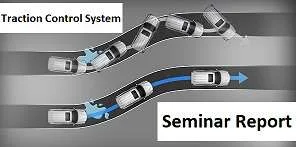Download Seminar Report on the topic Traction Control System which puts light on the modern Traction Control system basics, working, benefits and applications while discussing the history of the traction control systems and present world utilization. Download Seminar Report.
Traction Control System Seminar Report Abstract
Car accidents dominate the transportation industry in regards to the number of deaths that occur on the road, accounting for 94 percent. With over half a million car wrecks every year, safety aspects, such as traction control, are being constantly developed to keep drivers safer. By understanding modern-day safety features, drivers can stay well-informed of potential aftermarket options for their vehicles to keep them safe. Traction Control Systems are the modern-day solution to the problems such as unnecessary skids power loss due to less traction and railway track traction control. Whilst the old methods such as limited slip differentials are getting inefficient to handle the critical driving situations, the need for a more advanced traction control system arises and henceforth comes into picture the Electronic Traction Control System or the TRAC System.
Traction Control System Seminar Report Introduction
Traction refers to the maximum frictional force that can be produced between surfaces without slipping. In automobiles, traction is responsible for the movement of the vehicle. In the design of wheeled or tracked vehicles, high traction between wheel and ground is more desirable than low traction, as it allows for more energetic acceleration without wheel slippage.
Traction control is a technology designed to help your vehicle maintain traction, no matter how slippery the road surface is. Technically, it is a mechanical, hydraulic, or electric system that maintains or controls traction to any wheels driven by the engine. Unlike mechanical traction control systems of the past such as limited slip differentials, today’s systems are nearly all computer-controlled as they actively watch wheel slip. An option formerly reserved for performance, you can find traction control on all types of vehicles today.
The purpose of the Traction Control System is to prevent wheel spin from occurring due to acceleration. The maximum torque that can be transmitted to the wheels is determined by the coefficient of friction generated between the road and the tires. If the torque exceeds that level, the wheels are likely to spin. Conditions for Traction operation may include slippery road surfaces, acceleration while cornering, and hard acceleration.
The basic idea behind the need of a traction control system is the difference between the slips of different wheels or an apparent loss of road grip that may result in loss of steering control over the vehicle which leads to slipping of the vehicle and loss of power which results in uncontrolled cruising. A difference in slip may occur due to turning of a vehicle or differently varying road conditions for different wheels. And thus need to be controlled for a safer way to cruise.
This paper puts light on the modern Traction Control system basics, working, benefits and applications while appreciating the history of the traction control systems and present world utilization.
Traction Control System PPT
PPT presentation on the seminar topic Traction Control System briefly evaluates the Traction Control System TRAC, Types, 4-Wheel Drive Systems, Anti-lock Braking System, the block diagram of TRAC. The PPT further discusses the case studies, scope, wheel speed control against time. At last PPT discusses the Advantages and Disadvantages of Traction Control System and its applications with images.
Download Traction Control System Seminar Report and PPT


0 comments